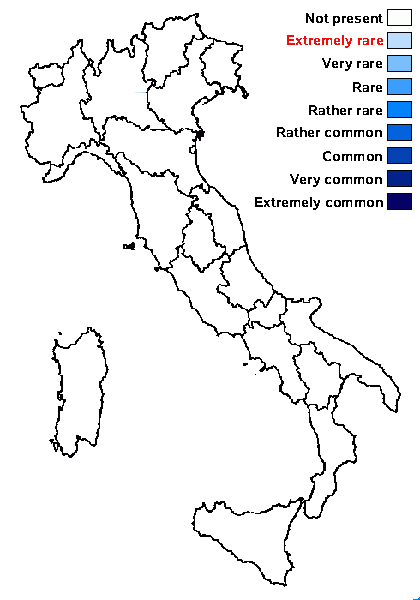Porina arnoldii Poelt & Vězda ex Hafellner & Türk
Stapfia, 76: 155, 2001
Synonyms: Sagedia koerberi f. rhododendri Arnold
Distribution:
Description: Thallus crustose, endosubstratic or thinly episubstratic, yellowish brown, grey-brown or brown-black, smooth to slightly warted, without a distinct prothallus. Perithecia 0.15-0.3 mm across, reddish brown, often brown-black in the apical part, hemispherical to conical, sometimes covered by a thalline layer at the base. Involucrellum orange-brown to reddish brown, often violet-brown to violet-black near the ostiole, completely surrounding the perithecium, 20-40 μm thick laterally, 50-75 μm thick in apical part; paraphyses thread-like, c. 1.5 μm thick, simple or rarely branched; hymenial gel I+ pale orange-yellow. Asci 8-spored, clavate-cylindrical, thin-walled throughout, functionally unitunicate, dehiscent by rupture of the apex, with no extruded inner layers. Ascospores 3-septate, hyaline, straight or slightly curved, narrowly fusiform, 20-30 x 3.5-5 μm. Pycnidia dark brown. Conidia bacilliform to almost ellipsoid, 4-5 x 1.2-1.5 μm. Photobiont trentepohlioid. Spot tests: thallus K-, C-, KC-, P-. Chemistry: thallus without lichen substances.Note: on branches of Rhododendron in the subalpine belt, apparently rare in the Alps, being only known from Austria, but perhaps overlooked elsewhere; to be looked for in the Italian Alps.
Growth form: Crustose
Substrata: bark
Photobiont: Trentepohlia
Reproductive strategy: mainly sexual
Poorly known taxon in need of further study

Predictive model
Growth form: Crustose
Substrata: bark
Photobiont: Trentepohlia
Reproductive strategy: mainly sexual
Poorly known taxon in need of further study

Predictive model
 Index Fungorum
Index Fungorum
 GBIF
GBIF

